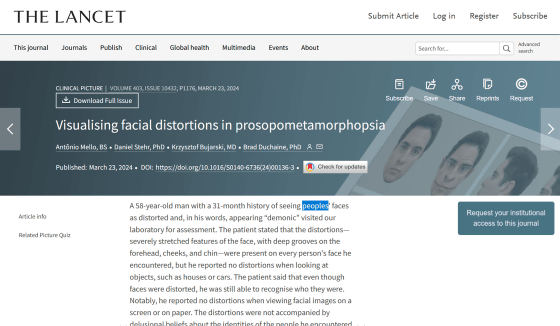A strange case has been reported in which ``a human face looks like a devil'', and a reproduction image of the face that is actually visible is also released

One day, a man named Victor Schaller, who lives in
Visualizing facial distortions in prosopometamorphopsia - The Lancet
https://www.thelancet.com/journals/lancet/article/PIIS0140-6736(24)00136-3/abstract

If faces look like demons, you could have thi | EurekAlert!
https://www.eurekalert.org/news-releases/1038350
Seeing Demons: Man's Rare Brain Condition Transforms Faces Into Monsters : ScienceAlert
https://www.sciencealert.com/seeing-demons-mans-rare-brain-condition-transforms-faces-into-monsters
Rare disorder causes man to see people's faces as 'demonic'
https://www.nbcnews.com/health/health-news/disorder-man-sees-demonic-faces-rcna144533
Schaller said that one day in November 2020, the human ears, nose, and mouth suddenly seemed to stretch backwards, and the forehead and cheeks began to look like there were deep grooves. Schaller, who was 59 years old at the time of writing the article, said, ``The first thing I thought was, ``I woke up in the devil's world.'' You can't imagine how scary it was.''
Mr. Schaller was depressed at first, but as he lives with his roommate and her two children, he gradually got used to seeing devilish faces. Thanks to this, I wasn't as scared when I saw my new demonic face in public, and I was able to tell people apart.
Meanwhile, an acquaintance of his who works as a teacher for the visually impaired told Schaller that he might have a rare visual disorder called ``prosthesia.'' Schaller attended the Social Perception Institute at Dartmouth College and was diagnosed with prosopagnosia in 2023.
Prosopagnosia is a disorder in which part or all of a person's face appears distorted, and although most cases resolve within a few days or weeks, some, like Schaller, continue to experience facial distortion for several years. In some cases, the image may continue to appear distorted. Case reports of prosopagnosia are already valuable, but Schaller's case is even more special in that ``only the actual human face appears distorted, but the same face in a photograph does not.'' did. Therefore, a research team led by Antonio Melo, a doctoral student at the Social Perception Research Institute, decided to reproduce the human face that Schaller was looking at.
The research team met the volunteer with Mr. Schaller, showed him a photo of the volunteer's face, asked him how his face actually looked, and then modified the photo using image editing software. Below is a comparison image showing the results. The photo on the left is an actual photo of the volunteer, and the photo on the right is a reproduction of the face that Schaller sees. Parts such as eyes, ears, nose, and mouth are tightened and deep wrinkles are carved, which certainly makes it look like a ``devil-like face.''

The profile looks like this. You can see that it still looks strange.

Fewer than 100 cases of prosopagnosia have been published so far, so researchers speculate that the cause may be a malfunction in the brain network that processes faces, but they do not know what causes the symptoms. is not well understood. Although some cases are associated with head trauma, stroke, epilepsy, and migraine, there are also cases without obvious structural changes in the brain.
In Schaller's case, he suffered a severe head injury when he hit his head on concrete when he was 43 years old, and suffered from carbon monoxide poisoning four months before his symptoms began. According to the study, an MRI scan revealed a lesion on the left side of the brain, which may be causing prosopagnosia.
The research team interviews one person every week or two who complains of symptoms of prosopagnosia, and the number of people suffering from prosopagnosia may be higher than reported. . Additionally, because awareness of prosopagnosia is low, doctors may not be able to diagnose prosopagnosia even if they are told about the symptoms.
Brad Duchesne, co-author of the study and lead researcher at Dartmouth College's Social Perception Lab, said: ``We've been diagnosed with schizophrenia by a psychiatrist, have vision problems, and are given antipsychotic medication.'' I have heard stories of patients with prosopagnosia who have been prescribed prescriptions for their facial dysmorphia.I have also heard of patients with prosopagnosia who have been prescribed prescriptions to improve their facial perception for fear that people will think that their facial distortions are a sign of mental illness. It's not uncommon for people not to talk about the problem.This problem is one that not many people understand.'

Related Posts:
in Science, Posted by log1h_ik







